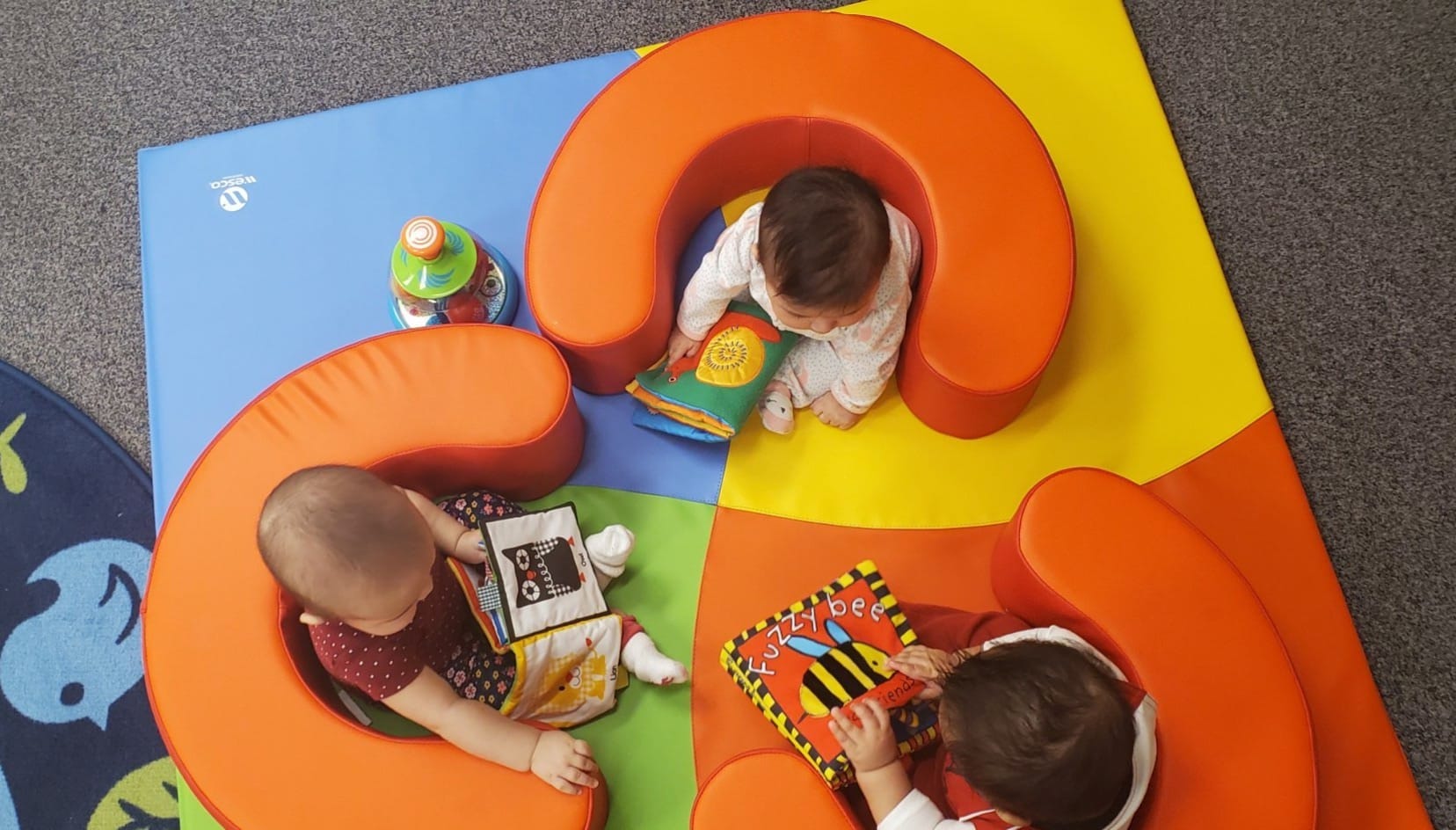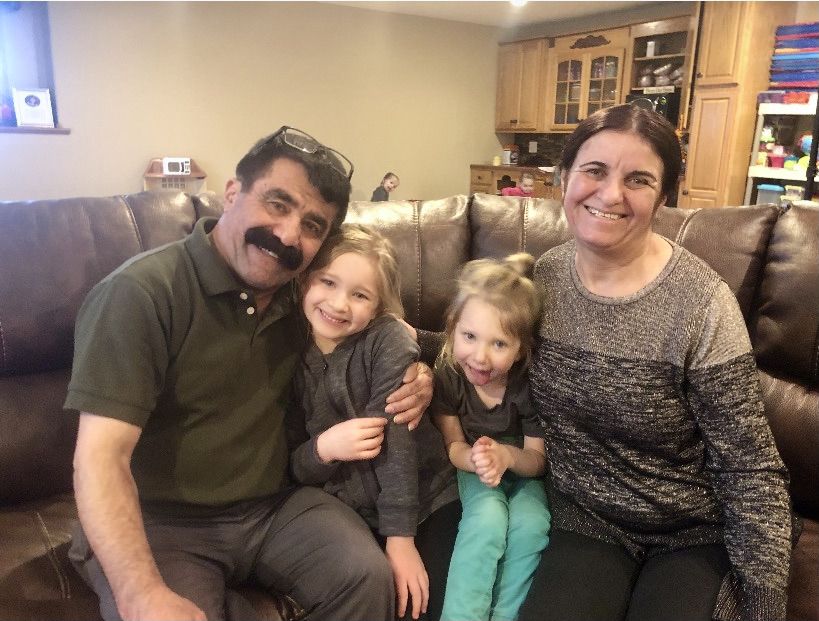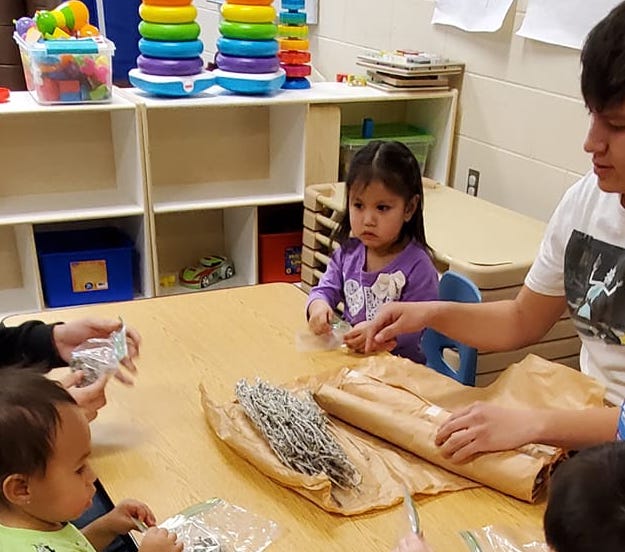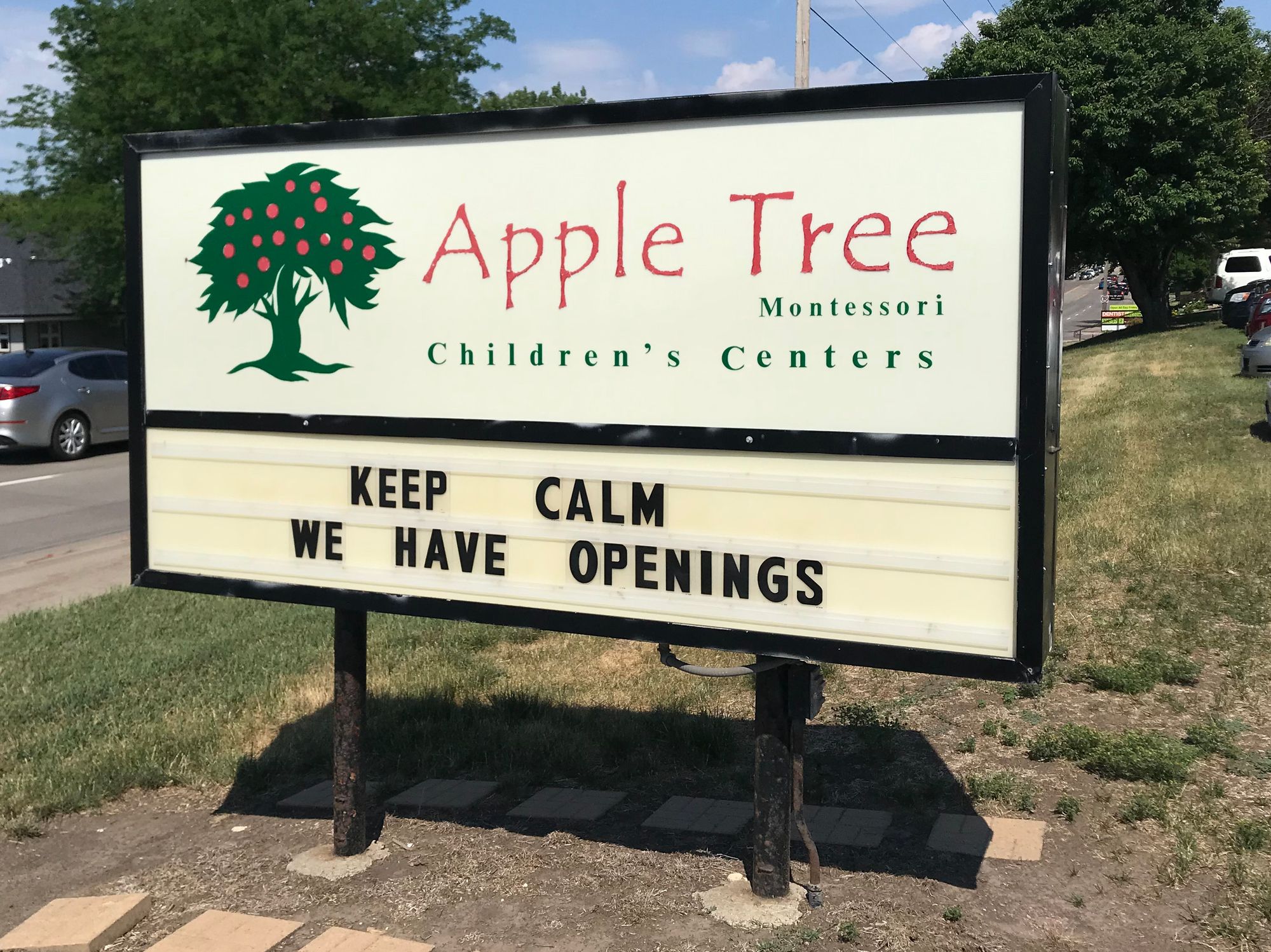A major decline in the availability of affordable child-care options in South Dakota has prevented some parents from entering the workforce and created financial and emotional hardships for low-income families and single parents trying to balance work and daycare needs.
Thousands of available daycare slots for children in South Dakota were lost during the COVID-19 pandemic, according to Early Learner South Dakota, a statewide child advocacy group. The resulting lack of affordable child care is a barrier for parents trying to return to the workforce during a time when the state and nation are experiencing vast labor shortages and businesses are in great need of employees.
Families unable to find child care, especially now that the school year has ended, are sometimes forced to limit or completely cut one parent’s job, and single parents are stuck paying a large portion of their income on out-of-home care.
Women in South Dakota have disproportionately left the workforce and are rejoining at a slower rate than men, according to statistics from the state department of labor, in part because of a lack of child care.
“Without child care, people can’t work,” said Pigeon Big Crow, program director for the Oglala Sioux Tribe Child Care and Development Program. “Without work, they rely more on social service programs. Having child care is vital to a local economy.”
Affordable daycare was limited prior to the pandemic, but the scarcity became far worse during the COVID-19 pandemic and remains so amid the pandemic recovery.
South Dakota has one of the highest rates of working parents in the nation and a shortage of state-registered spots for families seeking out-of-home care. More than 75% of children are in families with all available parents working. The state is second in the nation only to Massachusetts for the percentage of children under 5 who are in a child care setting for more than 10 hours each week, at 68%.
Some rural counties have zero state-registered child care options, such as Mellette, Sully, Shannon and Hyde counties, according to the South Dakota Department of Social Services care search tool. Day County has the highest number of children younger than 6 per childcare slot, yet has just two state-registered options, one of which is an after-school program.
Families of the 51,000 children in need of daycare can pay anywhere from $5,200 to $8,700 per year for each toddler or infant they enroll, according to a report from the Federal Reserve Bank of Minneapolis. For many South Dakota families, that is a big expense relative to their income: almost half of South Dakota children under the age of six live in a household with an income below 200% of the federal poverty standard. Families that make the median income on average pay about 11% of their income toward infant child care, according to Kids Count.
The majority of state-registered providers and child care programs remained open and operational during much of the past year, but many still imposed some COVID-19 restrictions, even though the state did not require them. For many providers, that meant operational changes and decreased revenue.
Many child-care facilities returning to a pre-COVID-19 capacity are struggling to find workers to care for more kids.
Parents and providers worried during the pandemic that widespread closures of daycare facilities could result. Many child-care providers were taking fewer kids because of capacity limits or because parents kept their children at home.

Some smaller home daycares couldn’t afford to stay open, compounding a decade-long trend of a decrease in home care centers in South Dakota. An exact number of facility closures is unknown because centers that take fewer than 12 children do not have to register and therefore may not be tracked by the state. A survey from the Bipartisan Policy Center estimates that 60% of daycares nationwide closed because they couldn’t afford to operate during the pandemic and many may not be able to return.
Almost half of the family child care home operators in South Dakota who responded to a National Association for the Education of Young Children survey said they lost income last year because families who still used their services struggled to pay for care. One-third said parents couldn’t pay any fees. About 33% said their operation wouldn’t be able to remain open or reopen without financial support.
In the past year, slots for children at registered home agencies were lost at a quicker rate than in the previous six years. More than 1,800 slots were lost across the state in 2020, according to Early Learners South Dakota. From 2015 to 2019, about 2,900 spaces and 244 providers for in-home registered centers were lost, according to data from the Kids Count program at the University of South Dakota. In that same period, 19 new out-of-home day care centers were added.
State-registered facilities have capacity for about half of children under 6 years old, according to Kids Count, and slots in home care options are on the decline. In 2010, there were 923 family child care homes registered with the state. In 2020, there were 403, according to Kids Count. As of June 2021, there were 377 family child care homes registered with the state, according to the Department of Social Services.
Whether that decline is because more family home care options are closing or because fewer are choosing to register with the state is unknown, said Xanna Burg, coordinator for Kids Count.
“Either way, the data tells us that there are fewer licensed or registered options for parents now than 10 years ago,” she said in a statement.
At one point during the last year, Nahida Barwari lost half of the children who were enrolled at her state-registered, in-home daycare. At least four families kept their children at home.
Barwari, who has been a daycare provider for the last 21 years in Sioux Falls, said some parents were frustrated with extra protocols and fearful of infection spread, and she had to sanitize and clean more often.
“It was hard, very hard,” she said.

Barwari was able to stay open during the pandemic, and is slowly seeing more parents bring their children back to her care. She has all the labor help she needs to eventually return to caring for 12 children, her full capacity as a state-registered family child care provider, because her husband and daughter are also licensed as child care workers.
“It’s getting better,” she said. “I think it’s getting busier because people are tired of having to work and care for their child.”
Parents across the state are seeking child care now more than ever with the school year ending, and with the continued closures of in-home care, more parents are turning to larger daycare centers.
“Parents are more willing to bring (their kids) into centers,” said Lisa Carson, director of Apple Tree in eastern Sioux Falls. “What I’ve heard is a lot of in-homes have been closing down or don’t know if they can stay open.”
Carson, who used to be an in-home care provider, said she personally knows at least three in-home workers who had to close their business because of the pandemic.
Apple Tree has experienced a “rush” within the past few months, Carson said. She added that she’s heard colleagues at other centers with larger capacities say the same.
“Everywhere else is getting pretty full,” she said.
Carson struggled to find staff during the school year and was worried about a continued worker shortage when parents flooded phone lines in the spring, but she’s starting to see an increase in interest from college students who are on summer break, she said.
Big Crow said the Oglala Sioux Tribe Child Care and Development Program is having a difficult time recruiting workers, even with a $500 sign-on bonus.
“It’s taking a toll on the ones who are here because their hours are longer,” Big Crow said. “I’m really concerned because I don’t want to burn them out.”
The development program operates six centers in five towns for Oglala Sioux Tribe members. In March 2020, the program switched to home-based care. Staff trained family members and other workers to provide home-based care and delivered meals and education materials to families.
“We’re very relative-oriented here,” Big Crow said. “If we hear of a relative who needs help, we raise our hands to help.”
Some parents have been hesitant to re-enroll their kids in centers, some of which reopened five weeks ago, for fear of coming into contact with other families who aren’t vaccinated. Some families prefer to continue in-home care from relatives. However, Big Crow said enrollment is starting to increase, and so is her need for staff. One location already has a waiting list seven children deep and another one is delaying its opening because of a need for workers.

The childcare industry has lost hundreds of thousands of workers nationwide. About 166,800 fewer people were working in child care in December 2020 than had been in those jobs at the same time in 2019, according to the Bureau of Labor Statistics. South Dakota does not track how many people work for child care programs, but the most recent data from the Bureau of Labor Statistics says there were about 2,400 people working in licensed child care agencies across the state in May 2020. Historical data was not available.
In 2020, child care workers in South Dakota had a median hourly wage of $10.39, according to the Bureau of Labor Statistics, or the equivalent to making about $21,600 per year if working full-time.
“Low wages for child care workers leads to staffing instability, making it challenging for child care businesses to retain workers and remain open,” said Burg, with Kids Count.
Bethesda of Aberdeen, a daycare facility in northeastern South Dakota, chose to limit its capacity to the children of employees for the long-term care facility but was able to keep all of its daycare workers, said April Wirth, operations director of the daycare.
Workers were reassigned to other tasks within the long-term care facility until the need for more child care providers returned this spring. The daycare is almost back to its pre-pandemic capacity, and Wirth said she expects to need additional workers soon.
The decision to close care to the community was tough, she said, and the facility still hasn’t regained all of the children who were formerly enrolled.
“We felt the right thing to do was to close to the community to try to keep the employees at the long-term care facility as safe as possible and still allow them to work because they were essential workers,” she said.
In a Brookings County study of child care availability released in May 2021, the majority of responding parents said they had to contact at least three providers before finding an opening. One respondent said she called 21 facilities and was only able to find a slot nine months out from her request.
Another family had to take two children to two different facilities because they could not find a location with two openings. A single mother reported that she spent almost three-fourths of her monthly income on childcare. Some families chose to keep a parent at home because they couldn’t find child care, and another parent had reservations about moving to Brookings over fears they wouldn’t be able to find an opening.
The survey also showed that the majority of parents who responded use un-registered in-home day cares, but would prefer to take their child to a facility licensed by the state.

About 800 child care facilities are licensed, but Early Learner South Dakota and Kids Count estimate there are more than 2,000 daycare providers across the state. Only licensed providers are able to receive relief funds given to the state, such as those in the American Rescue Plan.
The South Dakota Department of Social Services received more than $100 million for child care development and stabilization through the American Rescue Plan. That money can be used by providers for expenses such as personnel costs, rent, utilities, facilities maintenance, insurance, personal protective equipment, other health and safety practices and mental health services for child care provider staff and children.
“The State of South Dakota would likely have a hard time reaching out to more than half of the child care capacity in the state to promote these resources, because those child care providers are not registered,” according to the brief from the Federal Reserve Bank of Minneapolis.
The Oglala Sioux Tribe child care program is subsidy based, Big Crow said, and is the go-to option for families who need help paying for child care. Families receive aid based on income. CARES Act and American Rescue Plan funding is being used to pay 100% of the cost for families working in essential services and for families who just barely earn more than the threshold for aid but still can’t afford child care, Big Crow said. Part of that money is also being used to expand services to tribal members living in Rapid City.
The Federal Reserve Bank of Minneapolis report suggested that to improve South Dakota’s child care infrastructure, the Legislature should look at expanding already existing subsidy programs, consider requiring more agencies to register, research the current child care landscape more and bring more Native American, immigrant, and communities of color into conversations about improving child care.



